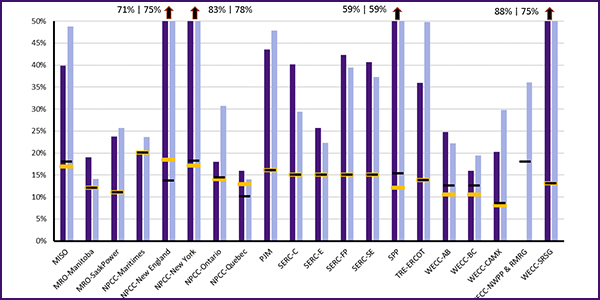Extreme weather poses the greatest risk to the reliability of North America’s electric grid for the winter months, according to NERC’s Winter Reliability Assessment (WRA) released Wednesday, although regional entities are generally well provisioned for the cold season. Additional concerns include fuel-supply and energy-assurance risks and the ongoing COVID-19 pandemic.
The annual WRA covers the months of December through February, aiming to identify potential reliability issues along with evaluating generation resource and transmission system adequacy.
For winter 2020/21, the ERO found that the anticipated reserve margin in all areas meets or exceeds the reference margin level. This indicates that “existing and planned resources … are adequate to manage risk of a capacity deficiency under normal conditions,” though NERC did acknowledge “noticeable reductions” in anticipated reserve margins compared to the prior year in MRO-Manitoba Hydro and SERC-Central, which covers all of Tennessee and portions of surrounding states.
Fuel Supply Presents Pain Points
Within this upbeat assessment, NERC offered some words of warning. The organization noted potential pain points with fuel supply, stating particularly that “New England generation continues to be limited by the availability of natural gas,” in line with FERC’s 2020/2021 Winter Energy market and Reliability Assessment released last month. (See COVID-19, Weather Drive FERC Winter Outlook.)
This is because of the use of gas in the region for both electric generation and heating. While under normal weather conditions such dual use should not pose a problem, a “more severe and prolonged winter event” that drains heating oil supplies more quickly than expected could lead to problems delivering enough natural gas to supply generators. The report points to the cold snap of January 2018 as the type of event that might create such a circumstance.
The southwest area of the Western Interconnection, including California, is also vulnerable to natural gas bottlenecks because of “limited natural gas storage and [lack of] redundancy in supply infrastructure.” As a result, extreme events such as pipeline disruptions or freezing temperatures at wellheads that affect production could limit the supply of gas available for the region, leading to energy emergencies.
Extreme weather poses a direct risk to reliability in several other regions: WECC, Texas Reliability Entity, MISO and NPCC-Maritimes are all advised that they “may need resource assistance in the form of transfers” during energy emergency alerts.
Widespread winter weather covering multiple assessment areas may also limit the availability of emergency imports. NERC provided operational risk scenarios involving ISO-NE and SERC-East, which covers North and South Carolina, to demonstrate how periods of extreme peak demand and high outage rates could lead to cancellation of transfers because of contracts allowing exporting entities to “prioritize serving native load.”
“These areas are selected because capacity transfers can be an important resource contribution toward meeting operating reserves,” NERC said.
COVID-19, Hurricane Impacts Continue
On the subject of the coronavirus, the report noted “increased uncertainty in electricity demand projections [along with] cybersecurity and operating risks,” but it could not identify any specific risks to the bulk power system likely to arise in the assessment period beyond the continuing need to protect system operators and field crews from infection. The report also recommended that operators pay close attention to generator maintenance scheduling and outage coordination, as many are still dealing with a backlog in planned maintenance delayed from spring and autumn.
Ongoing repair work from the 2020 hurricane season could complicate maintenance schedules as well. Despite intense effort to address the damage from Hurricanes Laura and Delta, and the completion of most major tasks, restoration activities are still unfinished in some parts of Louisiana. (See Industry Cooperation Key to Hurricane Recovery.)
NERC is still working on the 2020 Long-Term Reliability Assessment, which is planned for release in December. At this month’s meeting of the Board of Trustees, NERC Senior Engineer Mark Olson said most areas are expected to have sufficient on-peak capacity for the next five years, with potential trouble spots in Ontario and MISO. The team also previewed trends that bear watching over the long term, including the rapid projected growth of wind, solar and distributed energy resources across the North American grid. (See “Winter, Long-term Assessments Previewed,” NERC Board of Trustees/MRC Briefs: Nov. 5, 2020.)




